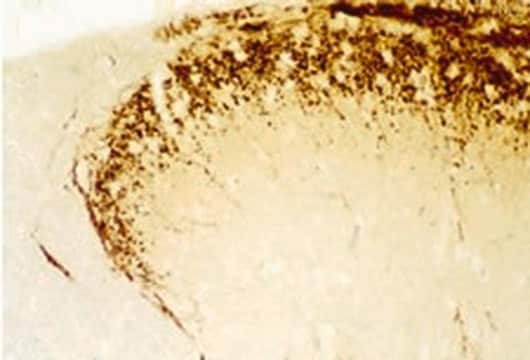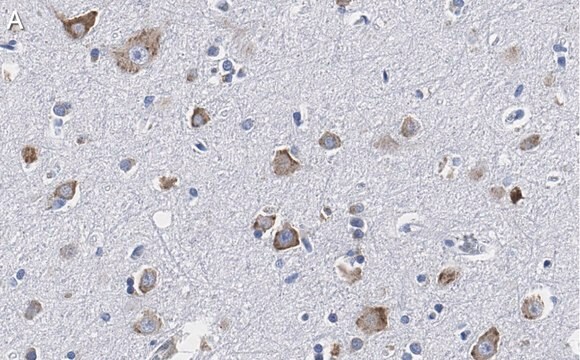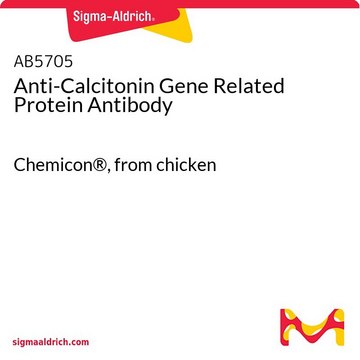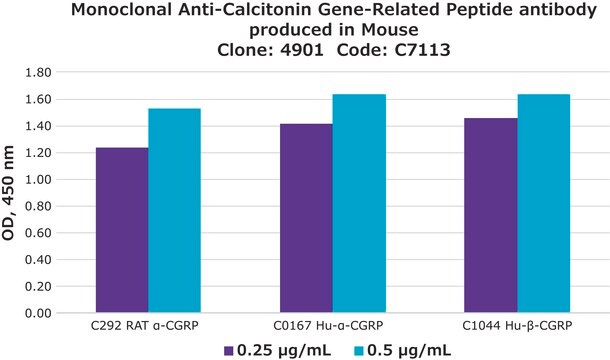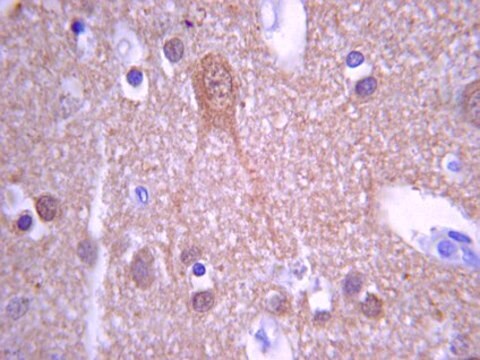AB15360
Anti-Calcitonin Gene Related Peptide Antibody
serum, Chemicon®
Synonym(s):
CGRP
Sign Into View Organizational & Contract Pricing
All Photos(1)
About This Item
UNSPSC Code:
12352203
eCl@ss:
32160702
NACRES:
NA.41
Recommended Products
biological source
rabbit
Quality Level
antibody form
serum
antibody product type
primary antibodies
clone
polyclonal
species reactivity
rat
manufacturer/tradename
Chemicon®
technique(s)
immunohistochemistry: suitable
NCBI accession no.
shipped in
wet ice
target post-translational modification
unmodified
Gene Information
human ... CALCA(796)
Specificity
Recognizes Calcitonin Gene Related Peptide (CGRP).
Immunogen
Synthetic calcitonin gene related peptide.
Application
Anti-Calcitonin Gene Related Peptide Antibody detects level of Calcitonin Gene Related Peptide & has been published & validated for use in IH.
Immunohistochemistry on frozen rat spinal cord: 1:2,000-1:4,000 using the Chemicon IHC-Select Kit with HRP-DAB detection system.
Optimal working dilutions must be determined by the end user.
Optimal working dilutions must be determined by the end user.
Research Category
Neuroscience
Neuroscience
Research Sub Category
CNS Control of Metabolism
Hormones & Receptors
CNS Control of Metabolism
Hormones & Receptors
Linkage
Replaces: AB1971
Physical form
Rabbit serum. Liquid.
Serum
Storage and Stability
Maintain at -20°C in undiluted aliquots for up to 12 months after date of receipt. Avoid repeated freeze/thaw cycles.
Legal Information
CHEMICON is a registered trademark of Merck KGaA, Darmstadt, Germany
Disclaimer
Unless otherwise stated in our catalog or other company documentation accompanying the product(s), our products are intended for research use only and are not to be used for any other purpose, which includes but is not limited to, unauthorized commercial uses, in vitro diagnostic uses, ex vivo or in vivo therapeutic uses or any type of consumption or application to humans or animals.
Not finding the right product?
Try our Product Selector Tool.
Storage Class
10 - Combustible liquids
wgk_germany
WGK 1
flash_point_f
Not applicable
flash_point_c
Not applicable
Certificates of Analysis (COA)
Search for Certificates of Analysis (COA) by entering the products Lot/Batch Number. Lot and Batch Numbers can be found on a product’s label following the words ‘Lot’ or ‘Batch’.
Already Own This Product?
Find documentation for the products that you have recently purchased in the Document Library.
Expression of G protein-coupled receptor 30 in the spinal somatosensory system.
Keiko Takanami,Hirotaka Sakamoto,Ken-Ichi Matsuda,Koji Hosokawa,Mayumi Nishi et al.
Brain Research null
Andrea M Sartori et al.
Experimental neurology, 348, 113937-113937 (2021-11-27)
Neurogenic lower urinary tract dysfunction typically develops after spinal cord injury. We investigated the time course and the anatomical changes in the spinal cord that may be causing lower urinary tract symptoms following injury. Rats were implanted with a bladder
Maria N Marangoni et al.
Cardiovascular diabetology, 13, 11-11 (2014-01-15)
Cardiomyopathy and distal symmetrical polyneuropathy (DSPN), including sensory and autonomic dysfunction, often co-occur in diabetic mellitus (DM) patients. However, the temporal relationship and progression between these two complications has not been investigated. Using a streptozotocin DM animal model that develops
Aline Dionizio et al.
Chemosphere, 273, 129607-129607 (2021-01-29)
Gastrointestinal signs and symptoms are the first signs of toxicity due to exposure to fluoride (F). This suggests the possibility that lower levels of subchronic F exposure may affect the gut. The aim of this study was to evaluate changes
Michał Bulc et al.
Journal of diabetes research, 2018, 4735659-4735659 (2018-08-25)
One of the most frequently reported disorders associated with diabetes is gastrointestinal (GI) disturbance. Although pathogenesis of these complications is multifactorial, the complicity of the enteric nervous system (ENS) in this respect has significant importance. Therefore, this paper analysed changes
Our team of scientists has experience in all areas of research including Life Science, Material Science, Chemical Synthesis, Chromatography, Analytical and many others.
Contact Technical Service
